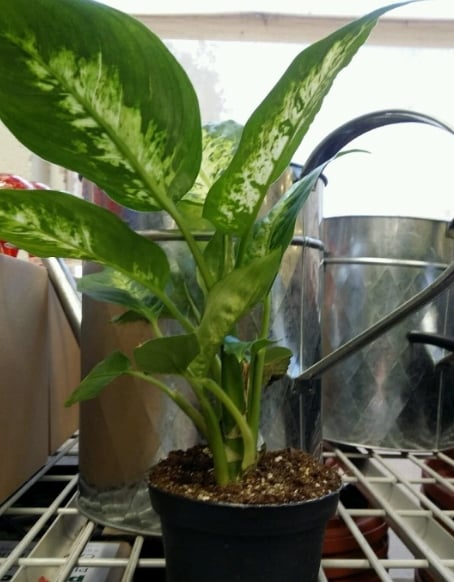Dieffenbachia, commonly known as dumb cane or sometimes mother-in-law’s tongue (shared with Sansevieria spp.), is a genus name for about 30 different herbaceous species plant in the arum family, Araceae. It is valued as houseplants since they are hardy and can thrive under a shade or low light.,
Dieffenbachia gets its name dumb cane because chewing the stem of some of its species like D. seguine will cause one to go speechless for several days to weeks. The loss of speech due to the mucous membranes irritating substances and oxalates will make the tongue and throat inflamed, swollen, and numb. Also, the sap is very irritating may damage the eye cornea.
While most of the dumb cane species are cultivated as house plants, the most commonly sold ones are D. oerstedii, D. amoena, D. maculata, and D. sequine, and these plants are native to the South and North American tropics.
Finally, note that various Dieffenbachia species may have other names that include tropic snow, giant dumbcane, spotted dumb cane, charming dieffenbachia, exotic perfection, dumbcane, leopard lily, gold dieffenbachia, variable dieffenbachia, among others.
Are they cat-friendly?
The beautiful and colorful foliage of the large oblong leaves with various combinations of cream, white or green and the fact that it is hardy and thrives under shade makes it an excellent houseplant.
Unfortunately, dumb cane is toxic to cats, i.e., all the dumbcane species, varieties, and cultivars are poisonous to cats and even your dogs.
Its cause of toxicity is insoluble calcium oxalates and proteolytic enzymes. It joins other plants like Chinese Evergreen (Aglaonema), elephant’s ear, pothos, arrowheads, peace lily, philodendron, and flamingo plant.
When your cats eat dumb canes or any other plant with insoluble calcium oxalates (that are contained inside specialized cells known as idioblasts), the idioblasts will burst, letting the insoluble calcium oxalates to pierce and penetrate your cat’s mucous membrane, resulting in the various symptoms your feline will have.
Symptoms
If your eats dumb cane leaves, they will experience several symptoms that may include the following:
- Oral discomfort, i.e., intense burning and irritation of their tongue, lips, or mouth
- Drooling
- Mouth pawing
- Vomiting
- Swallowing difficulties
- Unwillingness to eat
- Moderate to severe oral swelling (tongue, lips, and oral cavity)
Protection
People with dumb canes or other harmful, toxic, or poisonous plants like azalea, dracaena, tulips, amaryllis, lilies, poinsettia, corn plant, aloe vera, pothos, sago palms, daffodils, and so on, need to ensure your cats, dogs, or even kids cannot access them.
Some of the ways you can prevent access to these plants by your cats include the following:
- Have a cat-proof plant terrarium and grow this plant or any other toxic inside it. This is the best way to ensure your felines or even kids cannot access any poisonous houseplant.
- Invest in cat repellents such as PetSafe SSSCAT Spray Dog and Cat Deterrent, Motion Activated, or any other. However, note that experts have a varied opinion on how effective repellents are in keeping cats off plants.
- Train your cat not to eat houseplants or offer them alternative safer plants. These two can also not guarantee that your cat cannot eat toxic houseplants.
- Provide them with toys to minimize boredom. Bored kitties tend to munch more on non-typical food materials.
These are not the only way. You can try other methods like placing the plants in rooms where cats don’t often go, using some homemade repellents like cayenne pepper or placing orange peels on the pot where you are growing your house plants, and so on.
Conclusion
While it is quite bitter, we cannot guarantee that your cats won’t want to have a bite of dumb canes. Therefore, the best way to solve this problem is either not having these plants or going for cat-friendly plants like:
- Peperomia
- Haworthia
- Echeveria elegans
- African violets
- Prayer plants (calatheas)
- Spider plant
- Lipstick plant
- Christmas cactus
- Bromeliad
- Palms like parlor, ponytail, Chinese fan, areca, among others.

